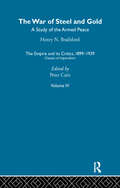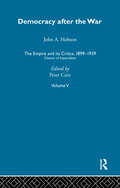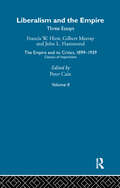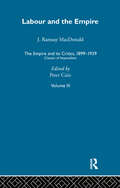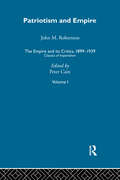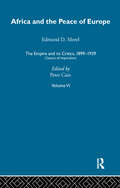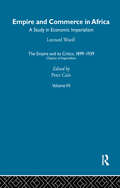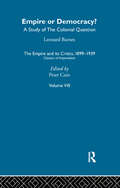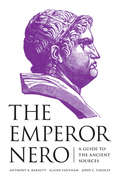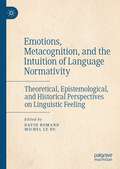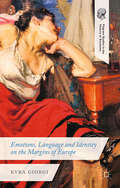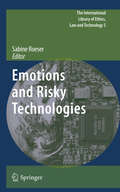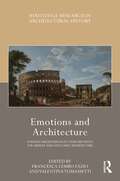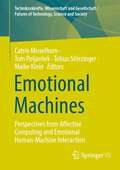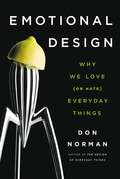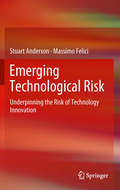- Table View
- List View
The Empire and its Critics, 1899-1939: Classics of Imperialism
by Henry N. BrailsfordThe eight books reprinted in this set played an important role in defining attitudes and expectations about imperialism on the British Left in the twentieth century. They are vital in understanding the transition from the liberal anti-imperialism of the nineteenth century to the more overtly socialist critiques of the twentieth.
The Empire and its Critics, 1899-1939: Classics of Imperialism
by Peter CainThe eight books reprinted in this set played an important role in defining attitudes and expectations about imperialism on the British Left in the twentieth century. They are vital in understanding the transition from the liberal anti-imperialism of the nineteenth century to the more overtly socialist critiques of the twentieth.
The Empire and its Critics, 1899-1939: Classics of Imperialism
by Peter CainThe eight books reprinted in this set played an important role in defining attitudes and expectations about imperialism on the British Left in the twentieth century. They are vital in understanding the transition from the liberal anti-imperialism of the nineteenth century to the more overtly socialist critiques of the twentieth.
The Empire and its Critics, 1899-1939: Classics of Imperialism
by Peter CainThe eight books reprinted in this set played an important role in defining attitudes and expectations about imperialism on the British Left in the twentieth century. They are vital in understanding the transition from the liberal anti-imperialism of the nineteenth century to the more overtly socialist critiques of the twentieth.
The Empire and its Critics, 1899-1939: Classics of Imperialism
by Peter CainThe eight books reprinted in this set played an important role in defining attitudes and expectations about imperialism on the British Left in the twentieth century. They are vital in understanding the transition from the liberal anti-imperialism of the nineteenth century to the more overtly socialist critiques of the twentieth.
The Empire and its Critics, 1899-1939: Classics of Imperialism
by Peter CainThe eight books reprinted in this set played an important role in defining attitudes and expectations about imperialism on the British Left in the twentieth century. They are vital in understanding the transition from the liberal anti-imperialism of the nineteenth century to the more overtly socialist critiques of the twentieth.
The Empire and its Critics, 1899-1939: Classics of Imperialism
by Peter CainThe eight books reprinted in this set played an important role in defining attitudes and expectations about imperialism on the British Left in the twentieth century. They are vital in understanding the transition from the liberal anti-imperialism of the nineteenth century to the more overtly socialist critiques of the twentieth.
The Empire and its Critics, 1899-1939: Classics of Imperialism
by Peter CainThe eight books reprinted in this set played an important role in defining attitudes and expectations about imperialism on the British Left in the twentieth century. They are vital in understanding the transition from the liberal anti-imperialism of the nineteenth century to the more overtly socialist critiques of the twentieth.
The Empire and its Critics, 1899-1939: Classics of Imperialism
by Peter CainThe eight books reprinted in this set played an important role in defining attitudes and expectations about imperialism on the British Left in the twentieth century. They are vital in understanding the transition from the liberal anti-imperialism of the nineteenth century to the more overtly socialist critiques of the twentieth.
The Empire and its Critics, 1899-1939: Classics of Imperialism
by Francis W. HirstThe eight books reprinted in this set played an important role in defining attitudes and expectations about imperialism on the British Left in the twentieth century. They are vital in understanding the transition from the liberal anti-imperialism of the nineteenth century to the more overtly socialist critiques of the twentieth.
The Empire and its Critics, 1899-1939: Classics of Imperialism
by John A. HobsonThe eight books reprinted in this set played an important role in defining attitudes and expectations about imperialism on the British Left in the twentieth century. They are vital in understanding the transition from the liberal anti-imperialism of the nineteenth century to the more overtly socialist critiques of the twentieth.
The Empire and its Critics, 1899-1939: Classics of Imperialism
by J. Ramsay MacDonaldThe eight books reprinted in this set played an important role in defining attitudes and expectations about imperialism on the British Left in the twentieth century. They are vital in understanding the transition from the liberal anti-imperialism of the nineteenth century to the more overtly socialist critiques of the twentieth.
The Empire and its Critics, 1899-1939: Classics of Imperialism
by E. D. MorelThe eight books reprinted in this set played an important role in defining attitudes and expectations about imperialism on the British Left in the twentieth century. They are vital in understanding the transition from the liberal anti-imperialism of the nineteenth century to the more overtly socialist critiques of the twentieth.
The Empire and its Critics, 1899-1939: Classics of Imperialism
by John M. RobertsonThe eight books reprinted in this set played an important role in defining attitudes and expectations about imperialism on the British Left in the twentieth century. They are vital in understanding the transition from the liberal anti-imperialism of the nineteenth century to the more overtly socialist critiques of the twentieth.
The Empire and its Critics, 1899-1939: Classics of Imperialism
by Leonard WoolfThe eight books reprinted in this set played an important role in defining attitudes and expectations about imperialism on the British Left in the twentieth century. They are vital in understanding the transition from the liberal anti-imperialism of the nineteenth century to the more overtly socialist critiques of the twentieth.
The Emperor Nero: A Guide to the Ancient Sources
by Anthony A. Barrett Elaine Fantham John C. YardleyNero's reign (AD 54–68) witnessed some of the most memorable events in Roman history, such as the rebellion of Boudica and the first persecution of the Christians—not to mention Nero's murder of his mother, his tyranny and extravagance, and his suicide, which plunged the empire into civil war. The Emperor Nero gathers into a single collection the major sources for Nero's life and rule, providing students of Nero and ancient Rome with the most authoritative and accessible reader there is.The Emperor Nero features clear, contemporary translations of key literary sources along with translations and explanations of representative inscriptions and coins issued under Nero. The informative introduction situates the emperor's reign within the history of the Roman Empire, and the book's concise headnotes to chapters place the source material in historical and biographical context. Passages are accompanied by detailed notes and are organized around events, such as the Great Fire of Rome, or by topic, such as Nero's relationships with his wives. Complex events like the war with Parthia—split up among several chapters in Tacitus's Annals—are brought together in continuous narratives, making this the most comprehensible and user-friendly sourcebook on Nero available.
Emotions, Metacognition, and the Intuition of Language Normativity: Theoretical, Epistemological, and Historical Perspectives on Linguistic Feeling
by David Romand Michel Le DuThis book proposes a comprehensive discussion of the issue of linguistic feeling, the subject’s metalinguistic capacity to intuitively apprehend the normative – lexical, syntactic, morphological, phonological… – dimensions of a definite language he or she is acquainted with. The volume’s twelve contributions aim to revisit a concept that, through a fluctuating terminology (“Sprachgefühl,” “sentiment de la langue,” “linguistic intuitions,” etc.), had developed, since the late 18th century, within a variety of cultural contexts and research traditions, and whose theoretical, epistemological, and historical ins and outs had not been systematically explored so far. Beginning with a long opening chapter, the book consists of two parts, one tracing the multifaceted approaches to linguistic feeling from Herder to Wittgenstein, and one offering a representative overview of the debates about the issue at stake in current linguistics and philosophy, while addressing the question of the place of metacognition, normativity, and affectivity in language processes.
Emotions, Language and Identity on the Margins of Europe (Palgrave Studies in the History of Emotions)
by K. GiorgiWhen a word describing an emotion is said to be untranslatable, is that emotion untranslatable also? This unique study focuses on three word-concepts on the periphery of Europe, providing a wide-ranging survey of national identity and cultural essentialism, nostalgia, melancholy and fatalism, the production of memory and the politics of hope.
Emotions and Risky Technologies (The International Library of Ethics, Law and Technology #5)
by Sabine Roeser“Acceptable Risk” – On the Rationality (and Irrationality) of Emotional Evaluations of Risk What is “acceptable risk”? That question is appropriate in a number of different contexts, political, social, ethical, and scienti c. Thus the question might be whether the voting public will support a risky proposal or project, whether people will buy or accept a risky product, whether it is morally permissible to pursue this or that potentially harmful venture, or whether it is wise or prudent to test or try out some possibly dangerous hypothesis or product. But complicating all of these queries, the “sand in the machinery” of rational decision-making, are the emotions. It is often noted (but too rarely studied) that voters are swayed by their passions at least as much as they are convinced by rational arguments. And it is obvious to advertisers and retailers that people are seduced by all sorts of appeals to their vanities, their fears, their extravagant hopes, their insecurities. At least one major thread of ethical discourse, the one following Kant, minimizes the importance of the emotions (“the inclinations”) in favor of an emphatically rational decision-making process, and it is worth mulling over the fact that many of those who do not accept Kant’s ethical views more or less applaud his rejection of the “moral sentiment theory” of the time, promoted by such luminary philosophers as David Hume and Adam Smith.
Emotions and Architecture: Forging Mediterranean Cities Between the Middle Ages and Early Modern Time (Routledge Research in Architectural History)
by Francesca Lembo Fazio Valentina TomassettiEmotions and Architecture: Forging Mediterranean Cities Between the Middle Ages and Early Modern Time explores architecture as a medium to arouse or conceal emotions, to build consensus through shared values, or to reconnect the urban community to its alleged ancestry. The chapters in this edited collection outline how architectonic symbols, images, and structures were codified – and sometimes recast – to match or to arouse emotions awakened by wars, political dominance, pandemic challenges, and religion. As signs of spiritual and political power, these elements were embraced and modulated locally, providing an endorsement to authorities and rituals for the community. This volume provides an overview of the phenomenon across the Italian region, stressing the transnationality of selected symbols and their various declinations in local contexts. It deepens the issue of refitting symbols, artworks, and structures to arouse emotions by carefully analysing specific cases, such as the Septizodium in Rome, the Holy House of Loreto in Venice, and the reconstruction of L'Aquila. The collection, through its variegated contributions, offers a comprehensive view of the phenomenon: exploring the issue from political, social, religious, and public health perspectives, and seeking to propose a new definition of architecture as a visual emotional language. Together, the chapters show how the representation of virtues and emotions through architecture was part of a symbolic practice shared by many across the Italian context. This book will be of interest to researchers and students studying architectural history, the history of emotions, and the history of art.
Emotions and Architecture: Forging Mediterranean Cities Between the Middle Ages and Early Modern Time (Routledge Research in Architectural History)
Emotions and Architecture: Forging Mediterranean Cities Between the Middle Ages and Early Modern Time explores architecture as a medium to arouse or conceal emotions, to build consensus through shared values, or to reconnect the urban community to its alleged ancestry. The chapters in this edited collection outline how architectonic symbols, images, and structures were codified – and sometimes recast – to match or to arouse emotions awakened by wars, political dominance, pandemic challenges, and religion. As signs of spiritual and political power, these elements were embraced and modulated locally, providing an endorsement to authorities and rituals for the community. This volume provides an overview of the phenomenon across the Italian region, stressing the transnationality of selected symbols and their various declinations in local contexts. It deepens the issue of refitting symbols, artworks, and structures to arouse emotions by carefully analysing specific cases, such as the Septizodium in Rome, the Holy House of Loreto in Venice, and the reconstruction of L'Aquila. The collection, through its variegated contributions, offers a comprehensive view of the phenomenon: exploring the issue from political, social, religious, and public health perspectives, and seeking to propose a new definition of architecture as a visual emotional language. Together, the chapters show how the representation of virtues and emotions through architecture was part of a symbolic practice shared by many across the Italian context. This book will be of interest to researchers and students studying architectural history, the history of emotions, and the history of art.
Emotional Machines: Perspectives from Affective Computing and Emotional Human-Machine Interaction (Technikzukünfte, Wissenschaft und Gesellschaft / Futures of Technology, Science and Society)
by Catrin Misselhorn Tom Poljanšek Tobias Störzinger Maike KleinCan machines simulate, express or even have emotions? Is it a good to build such machines? How do humans react emotionally to them and how should such devices be treated from a moral point of view? This volume addresses these and related questions by bringing together perspectives from affective computing and emotional human-machine interaction, combining technological approaches with those from the humanities and social sciences. It thus relates disciplines such as philosophy, computer science, technology, psychology, sociology, design, and art. The volume offers readers interested in the phenomenon of emotional machines new perspectives from a variety of disciplines and addresses fundamental questions that will become pressing in the foreseeable future as emotional machines increasingly populate our everyday lives.
Emotional Design: Why We Love (or Hate) Everyday Things
by Don NormanWhy attractive things work better and other crucial insights into human-centered designEmotions are inseparable from how we humans think, choose, and act. In Emotional Design, cognitive scientist Don Norman shows how the principles of human psychology apply to the invention and design of new technologies and products. In The Design of Everyday Things, Norman made the definitive case for human-centered design, showing that good design demanded that the user's must take precedence over a designer's aesthetic if anything, from light switches to airplanes, was going to work as the user needed. In this book, he takes his thinking several steps farther, showing that successful design must incorporate not just what users need, but must address our minds by attending to our visceral reactions, to our behavioral choices, and to the stories we want the things in our lives to tell others about ourselves. Good human-centered design isn't just about making effective tools that are straightforward to use; it's about making affective tools that mesh well with our emotions and help us express our identities and support our social lives. From roller coasters to robots, sports cars to smart phones, attractive things work better. Whether designer or consumer, user or inventor, this book is the definitive guide to making Norman's insights work for you.
Emily in Paris: The Official Authorized Companion
by Emily in ParisThe official authorized companion to the much-loved Netflix show Emily in Paris.Paris, J'Adore! is Emily Cooper's diary about her life in France so far. From leaving her boyfriend in Chicago to starting at marketing firm Savoir in Paris, it reveals all the thrill, fear and confusion Emily experiences as she embarks on her new life. She becomes acquainted not only with French workplace etiquette - the long lunches, the arguments, the determined reluctance to use social media - but also with Gabriel, the hottest chef in town. Some things, though, are beyond comprehension: like why the first floor in a Parisian apartment building is the second floor and the first floor is the ground floor.As the months go by, Emily learns how it's perfectly normal to have a glass of Sancerre for breakfast and how you should never turn up early at work. But more than anything, she learns about love, female friendships, and how exciting it is to step out of your comfort zone in this beautiful and intriguing city.Paris, J'Adore! is also a guidebook to how to be a Parisian, with tips on fashion, romance, and where to capture the perfect selfie in the City of Lights.Written in Emily's voice, it will contain the following sections:1. Emily's Fashion Paris - all about Emily's favourite outfits and designers - from Cadault to Chanel - as well as tips on what to wear to the beach, where to find the best boutiques, and how to dress like a Parisian; 2. Emily's Romantic Paris - the best bridges to kiss and break up on, where you can find the most breathtaking views and the most perfect backstreets, why the magic of the Eiffel Tower twinkling at night is the most intoxicating backdrop to falling in love, and a selection of the most evocative French songs to sing along to;3. Emily's Secret Paris - where Parisians show Emily the real Paris, from the hamman in the Mosquée de Paris to the Atelier des Lumières, and from small independent French cinemas to delightful neighbourhood restaurants; 4. Emily's Workplace Paris - how to navigate tensions and emotions in a French boardroom, lunch and coffee break rituals, Sylvie's own version of Savoir's Employee Handbook, and how to teach the French about social media; 5. Emily's Escapades from Paris - including the delights of the Champagne region, the sheer glamour of Saint-Tropez and the opulence of the Château de Versailles.Packed with four-colour photographs, exquisite illustrations and beautiful shots of Paris, Paris, J'Adore! is a hugely desirable gift book for all the fans of the show.
Emerging Technological Risk: Underpinning the Risk of Technology Innovation
by Stuart Anderson Massimo FeliciClasses of socio-technical hazards allow a characterization of the risk in technology innovation and clarify the mechanisms underpinning emergent technological risk. Emerging Technological Risk provides an interdisciplinary account of risk in socio-technical systems including hazards which highlight:· How technological risk crosses organizational boundaries,· How technological trajectories and evolution develop from resolving tensions emerging between social aspects of organisations and technologies and· How social behaviour shapes, and is shaped by, technology.Addressing an audience from a range of academic and professional backgrounds, Emerging Technological Risk is a key source for those who wish to benefit from a detail and methodical exposure to multiple perspectives on technological risk. By providing a synthesis of recent work on risk that captures the complex mechanisms that characterize the emergence of risk in technology innovation, Emerging Technological Risk bridges contributions from many disciplines in order to sustain a fruitful debate. Emerging Technological Risk is one of a series of books developed by the Dependability Interdisciplinary Research Collaboration funded by the UK Engineering and Physical Sciences Research Council.
